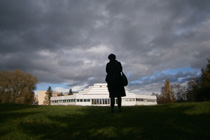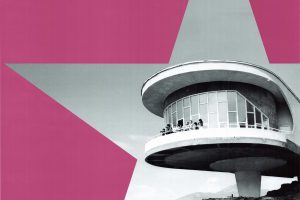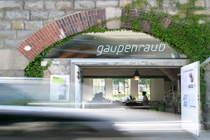Congress
19th Vienna Architecture Congress
Soviet Modernism 1955-1991. Unknown Stories

19th Vienna Architecture Congress
© Alexandra Wachter
On the occasion of the exhibition ‘Soviet Modernism 1955–1991. Unknown Stories’ (08.11.2012 – 25.02.2013) the 19th Vienna Architecture Congress will gather in a single place, for the first time outside Russia, the most important experts on this as yet little researched epoch of Soviet modernism. Architectural historians, urban planners, culture theorists and architects from the former Soviet republics together with other international experts will examine in four thematic panels the areas ‘Capitalism versus Communism. Architecture of Modernism in East and West’, ‘The Soviet Heritage: National or Russian?’, ‘Local Modernisms. Centrifugal Forces in the Architecture of the USSR’ and ‘Built Ideology’ from the viewpoints of architectural history, politics and economics. As a further highlight the Architekturzentrum Wien is looking forward to hosting the ‘last Congress of the USSR Architects’ – 25 years after the last assembly of the Union of Architects of the USSR in Moscow in 1987.
The Congress will be held in German, Russian and English.
Each talk lasts about 30 mins., followed by 15 mins. for questions from the audience.
PROGRAMME
SATURDAY, 24.11.2012
CAPITALISM VERSUS COMMUNISM. ARCHITECTURE OF MODERNISM IN EAST AND WEST
The western view of the history of 20th century architecture continues to be strongly influenced by the perspective of the Cold War. Only recently have scholars started to question this approach and to open up a new view of “World Architecture” that also includes the cultural achievements of the communist world. The first part of this congress focuses on the political, social and formal viewpoints of Soviet Modernism and relates them to parallel developments in the West. Although the conditions under which architecture was produced in the Eastern Bloc – from the way buildings were commissioned to their design and implementation – were organized in a completely different way than in the West, often the results were not so far removed from each other. After the Second World War both East and West were confronted with pressing social and urban planning questions.
Moderated by: Katharina Ritter (Austria), Curator of the Exhibition
10am Welcome: Dietmar Steiner (Austria), Director Az W
10.15am Introduction: Katharina Ritter (Austria), Curator of the Exhibition
10.30am Lecture ‘The Empire’s Last Style. A View from the 21st Century’
Vladimir Belogolovsky (USA), Curator
11.15am Lecture ‘Modernist Architecture: On Both Sides of the Iron Curtain’
Olga Kazakova (Russia), Art Historian
12pm-1pm Lunch break
THE SOVIET HERITAGE: NATIONAL OR RUSSIAN?
The 15 independent states that emerged after the collapse of the Soviet Union were confronted with the task of defining their identity. The way in which the Soviet period is assessed differs from country to country. Until the collapse of the Soviet Union the slogan first propagated under Stalin, ‘National in Form, Socialist in Content’, which imposed a return to ‘ethnic’ elements indicated the cultural direction to be followed. The process of sovietisation was equated with the struggle against backwardness. The aim was to overcome the ‘feudal rudiments’ and to employ ‘progressive national forces’ to establish socialism. But, as is known, the regime was not only associated with modernization; in the collective consciousness of the republics often everything that could be described as ‘soviet’ was regarded as coming from outside as ‘foreign’ and ‘Russian’. In this thematic panel a look is taken at the extent to which the architecture of this period is seen as a national or colonial heritage and the value it has in the different republics is examined.
Moderated by: Ekaterina Shapiro-Obermair (Russia, Austria), Curator of the Exhibition
1pm Introduction: Ekaterina Shapiro-Obermair (Russia/Austria), Curator of the exhibition
1.15pm Lecture ‘The Heritage of Modernism. Save or forget?’
Irina Chepkunova (Russia), Deputy Director of Research, Shchusev State Museum of Architecture, Moscow
1.25pm Lecture ‘Prevailing Attitudes on Soviet Architectural Heritage in Georgia’
Levan Asabashvili (Georgia), Architect
2.10pm Lecture ‘Architectural Prototypes for the National’
Dimitrij Zadorin (Belarus, Netherlands), Architect
2.55pm Lecture ‘Save ‘Moskva’ Open Air Cinema or Rereading the Paradoxes of Soviet and Post Soviet Armenian Public Consciousness’
Ruben Arevshatyan (Armenia), Artist, Art Critic and Independent Curator
3.40pm Discussion with Ruben Arevshatyan, Levan Asabashvili, Irina Chepkunova, Ruslan Muradov, Mait Väljas, Dimitrij Zadorin
4.10pm-5pm Break
followed by:
THE LAST CONGRESS OF THE USSR ARCHITECTS
The 8th congress of the Union of Architects in the USSR took place in June 1987. Like every five years the elite of Soviet architecture came together to elect a new board. Despite a tangible sense of imminent change there was nothing to suggest that this powerful and influential organization, which influenced both the professional and private lives of its members, would soon cease to exist. Now, 25 years later, architects of ‘Soviet Modernism’, who today live scattered across the entire world, are meeting in Vienna. They report, as contemporary witnesses, about their experiences of working in the USSR. This event was initiated by Felix Novikov. In organizational terms it has received support from the Union of Architects of Russia and the International Association of Unions of Architects.
Moderator: Andrey Bokov (Russia), President of the Union of Architects of Russia
Curator: Felix Novikov (Russia, USA), Architect
5pm Introduction: Dietmar Steiner (Austria), Director Az W
5.05pm Lecture ‘The State and the Union of Architects’
Andrey Bokov (Russia), President of the Union of Architects of Russia
5.20pm Lecture and Slideshow ‘Architecture-Perestroika’
Felix Novikov (Russia, USA), Architect
5.50pm Lecture ‘Soviet Modernism in Russia’
Yury Gnedovsky (Russia), Architect
6.30pm Lecture ‘My Work in Uzbekistan’
Andrey Kosinskiy (Russia), Architect
6.50pm Lecture ‘A »ufo« in Crimea’
Igor Vasilevsky (Russia), Architect
SUNDAY, 25.11.2012
LOCAL MODERNISMS. CENTRIFUGAL FORCES IN THE ARCHITECTURE OF THE USSR
Contrary to the western prejudice that views the architecture of all communist states as being essentially similar in style due to the uniform conditions of production and imposed standards, here an examination will be made of the rich diversity of local strategies, forms and scales within the Soviet Union. Whereas Scandinavian architecture provided a model for the Baltic countries, architecture in Belarus and Ukraine can be described as ‘proto-soviet’. In the republics of central Asia the extent to which national roots and national methods of construction should be used was an important question. In the Caucasus local architects’ elites emerged with an autochthon style. Which were the models, traditions and materials that architects in the individual republics wanted and were able to use? The myths of national master architects and masterpieces, independent local styles and subversive resistance to the system are subjected to scrutiny.
Moderated by: Georg Schöllhammer (Austria), tranzit.at, founding editor of ‘springerin’
10am Introduction: Georg Schöllhammer (Austria), tranzit.at, founding editor of ‘springerin’
10.15am Lecture ‘Baltic Modernisms’
Mart Kalm (Estonia), Professor and Dean at the Estonia Academy of Arts, Tallin
11am Lecture ‘Local Modernism and Global Orientalism: Building a Soviet Orient’
Boris Chukhovich (Uzbekistan, Canada), Curator and Researcher (UQAM)
11.45am Lecture ‘Artists and Architects in late Soviet Ukraine’
Oleksandr Burlaka (Ukraine), Architect & Oleksiy Radynski (Ukraine), Editor ‘Politychna Krytyka’
12.30pm Discussion with Oleksandr Burlaka, Boris Chukhovich, Sergej Fedorov, Mart Kalm, Oleksiy Radynski
1pm-2pm Lunch break
BUILT IDEOLOGY
‘The secular Soviet state was well known for its elaborate »socialist rites« that marked important milestones in life and extended from birth to marriage, and to death’, writes Marija Dremaite in her contribution to the catalogue. On the basis of the Marxist hypothesis that ‘being determines consciousness’ architecture occupied a special position in the Soviet Union. The built environment should help to form the Soviet citizen as part of a communist world order. The last part of the congress follows the traces of this built ideology. From urban planning and the mass housing programme to representational buildings, palaces of culture and sport to recreation facilities, the typologies of the Soviet Union are addressed and their role as ‘urban representation apparatus’ and ‘generator for social emotions’ is scrutinized.
Moderated by: Alexandra Wachter (Germany, Austria), Curator of the Exhibition
2pm Introduction: Alexandra Wachter (Germany, Austria), Curator of the Exhibition
2.15pm Lecture ‘Urban Spaces of Socialist Modernity’
Elke Beyer (Germany), Historian at the ETH Zurich
3pm Lecture ‘Inventing a Soviet Ritual: Dramatic New Architecture’
Marija Dremaite (Lithuania), Architectural Historian
3.45pm Lecture ‘«Republic of Red Scarves» – the Architecture of Artek’
Wolfgang Kil (Germany), Architectural Critic and Publicist
4.30pm Lecture ‘Two Generations of Architects in Communism’
Vladimír Šlapeta (Czech Republic), Architect and Architectural Historian
Subject to alteration
Thanks to: Tranzit.at, Sweet Sixties, ERSTE Stiftung, Allianz Kulturstiftung, EU Culture
Public Funding:
Geschäftsgruppe Stadtentwicklung und Verkehr
Bundesministerium für Unterricht, Kunst und Kultur
Geschäftsgruppe Kultur und Wissenschaft
Sponsor: ARCHITECTURE LOUNGE


